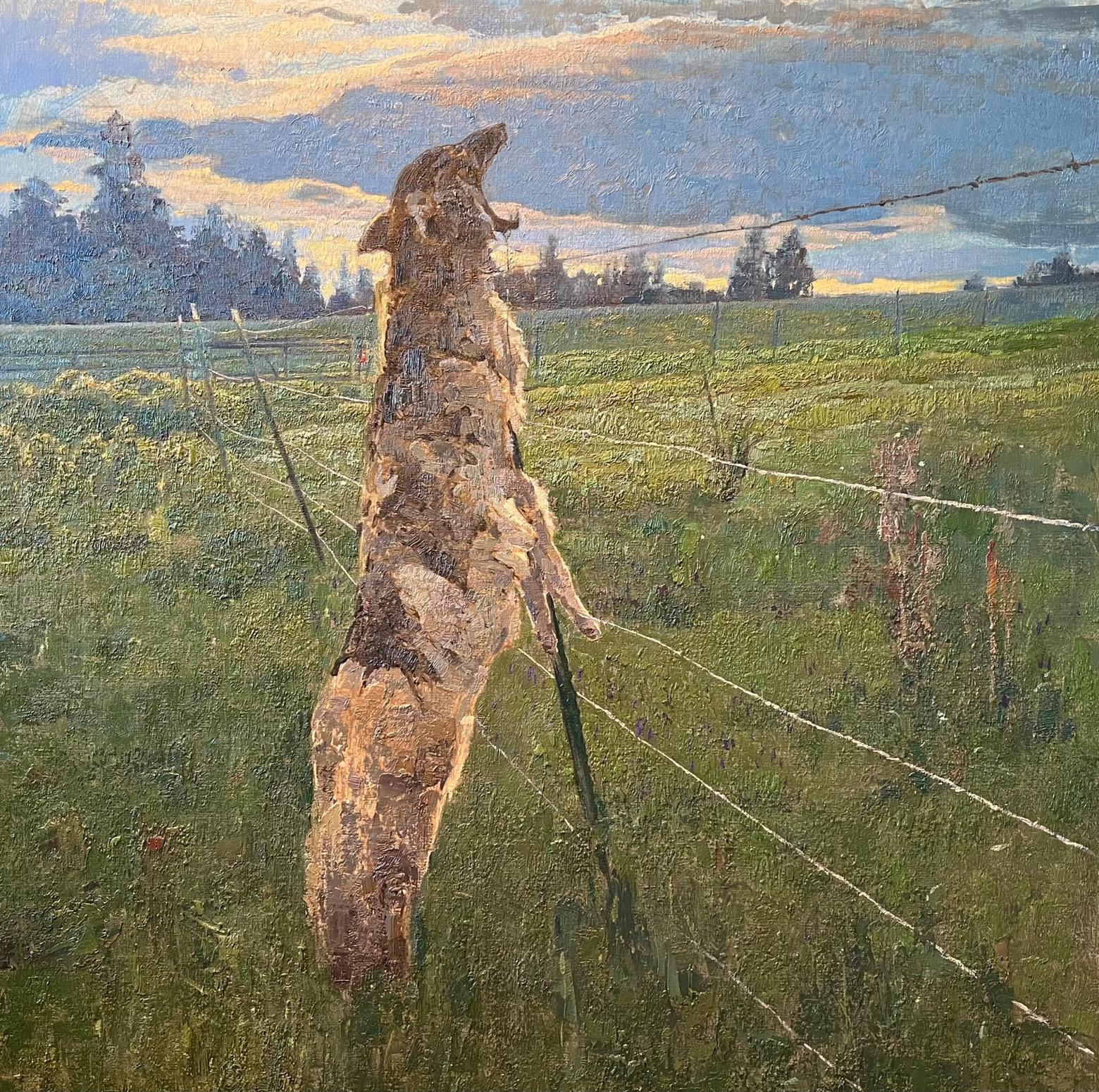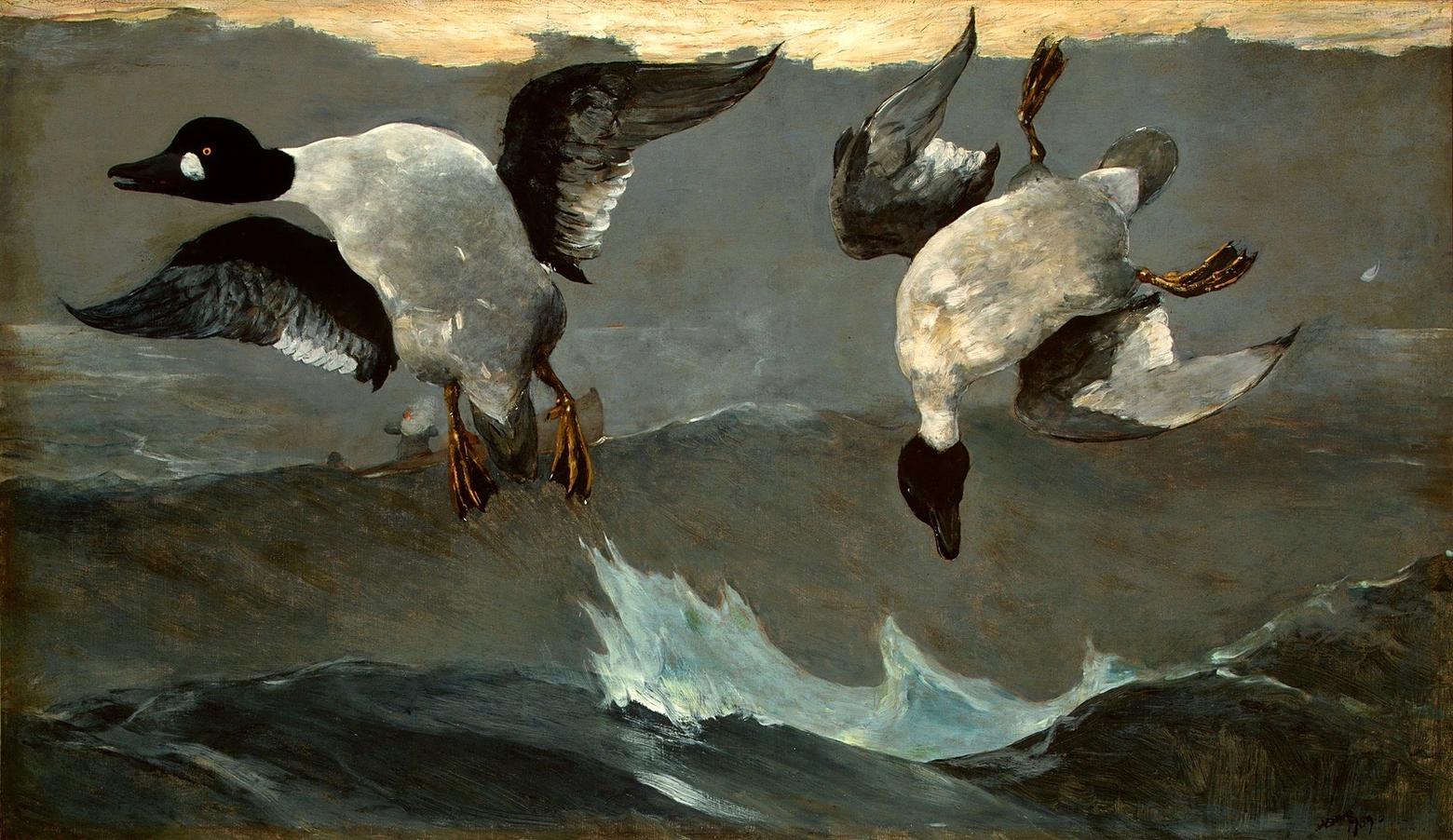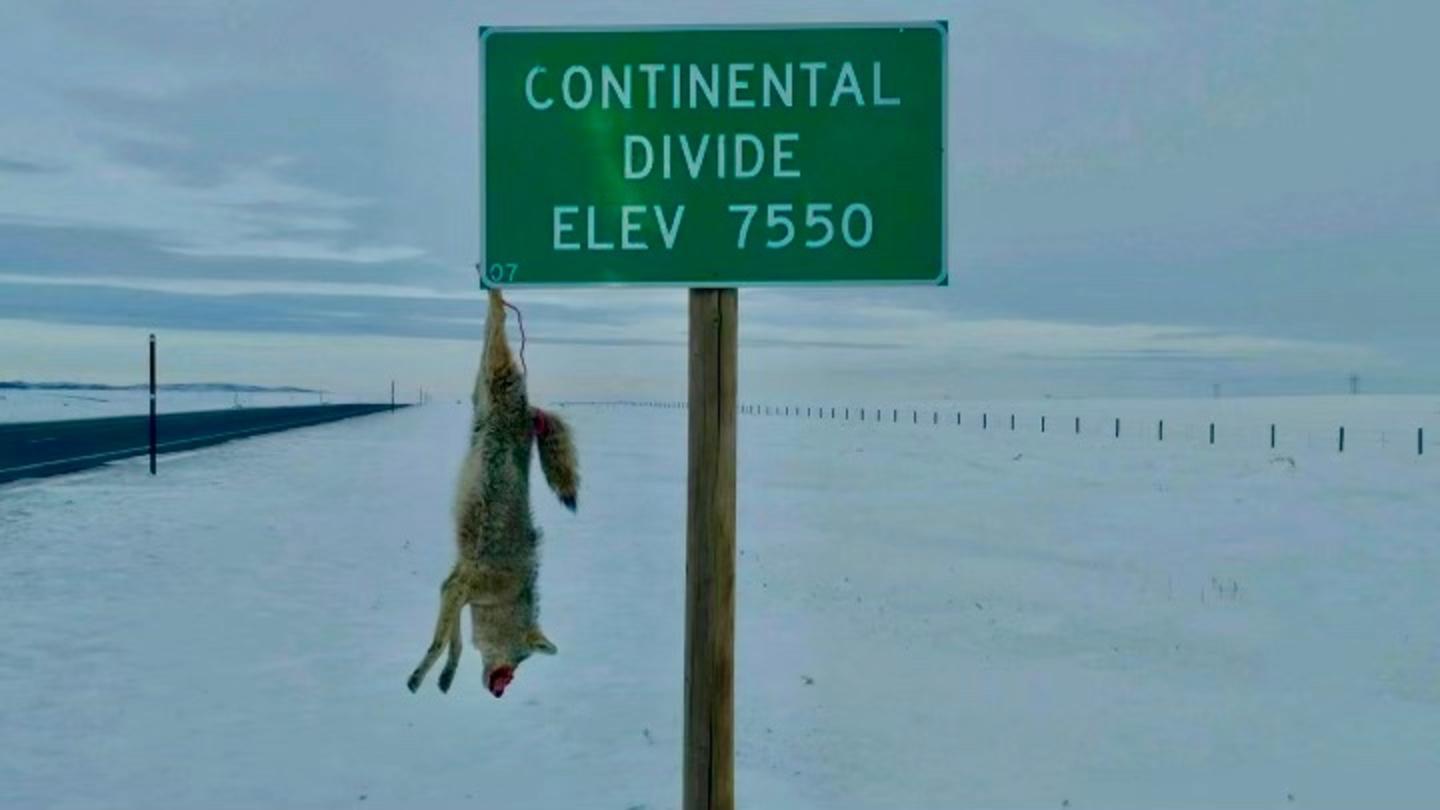Back to StoriesThe Story Behind A Coyote Painting Titled ‘Mayday!’
Quick: what comes to mind when you think of “Western art?”
December 21, 2022
The Story Behind A Coyote Painting Titled ‘Mayday!’Artist George Carlson encountered a disturbing scene along a rural county road in the West. To process the experience he created one of the most powerful works of his career
by Todd Wilkinson
Quick: what comes to mind when you think of “Western art?”
How ironic that so much artistic subject matter being created today in this, the third decade of the 21st century, is focused on embellished imagery of the "Old West” that existed two centuries ago? And to which the artists making it had no direct contact.
Scenes between the frames that for viewers reinforce common romanticized perceptions of the West that, except anecdotally, did not exist. No other region in the country is stuck in such a backward, time-warped view of pondering its own identity. Maybe it’s worth reflecting upon why.
There is, however, among a daring group of distinguished contemporary nature painters, a belief that landscapes and human characters in front of us now, in our time, are worthy of pictorial exploration. Interpreting the West as it really is can provide provocative fodder for honestly contemplating what is generally referenced as “Western cultural values.”
° ° ° °
On an evening in May last spring, George Carlson was driving his pickup down a gravel road in the Idaho Panhandle region southeast of Coeur d’Alene, his eyes piqued to the rolling pastoral countryside as he scouted scenes that might possibly form the basis for new paintings.
Carlson at age 82 is no ordinary fine artist. He is the only person in the last half century to win the coveted Prix de West Purchase Award in two different media, as both a sculptor and as a painter. It’s paradoxical that the Carlson piece featured above is based on a surprise encounter he had and of which he never previously contemplated being in a painting yet, arguably, it is one of the most impactful of his career.
"Mayday!" springs forth from a reality of the modern West, a still ongoing holdover from the days of the "frontier,” that some readers here may find shocking. But it captures a duality many of us would rather glance away from. An appearance of sublime beauty from afar lures in the eyes, and then, after our senses make vivid what we are seeing, we come to realize a truth that is impossible to un-remember.
For all of its sanctified majesty, the rural West remains home to some traditions that masquerade as virtuous cultural values though when we are confronted with them up close, they give us pause. Searching for the right words to explain how Carlson’s own conscious awareness was jolted out of its comfort zone, the artist says, “The content didn’t coincide with my own feeling toward Nature. So I asked myself: What compelled me to paint a dark subject such as this?”
The brazen stringing up of a dead coyote by an anonymous person, obviously done to make a statement and elicit a response, left Carlson disturbed. He put his power of observation to work in order to process what he was seeing and Mayday! was the result.
His painting portrays the coyote as he found it—killed and then positioned sadistically on a barbed wire fence. At first glance, Carlson thought “how odd,” and then he got out of his truck and went nearer for further examination to investigate. The coyote hadn’t just been slain and its body put on ornamental display, but its mouth was deliberately wired open.
A multitude of impressions raced through Carlson’s mind, “thoughts that were deferential and disturbing all at once,” he says. “On the one hand, I was fascinated by the beauty of the coyote’s coat but distressed by the irreverent brutal display.” Trying to discern the motivation of the unknown person behind the action, he explains, “The longer I stood there the more convinced I was that it should be painted. With my mind fully engaged, all I was thinking about was how to capture and communicate this experience. As an artist, it’s all about learning how to see and to trust your feelings—to take in your surroundings in a mindful way.”
In front of him was not the sanguine loom of the Tetons, or a bull elk bugling sonorously in the fall, or cowboys on horseback blithely driving their cattle herds as part of autumn roundup—all of which have been painted a million times by Western artists before.
Instead, raw, overt, chilling, the coyote symbolizes metaphorically a kind of wildlife lynching. How could it be interpreted any other way? Imagine what the level of public outrage would be if the animal had been a golden retriever.
“I have, at times, in the West, witnessed coyotes hanging by their hind legs looped over fence posts,” he says. “But there was something more sinister about this scene, with the coyote’s jaw wired open as in a distress call, howling into the breeze of the evening sky, hence the title.”
Cleverly, the painting’s title is intended to be a double entendre, alluding not only to the month of its genesis but to the word signifying the emergency signal, calling for help, sent from a doomed airplane or ship about to crash or sink.
“I have, at times, in the West, witnessed coyotes hanging by their hind legs looped over fence posts. But there was something more sinister about this scene, with the coyote’s jaw wired open as in a distress call, howling into the breeze of the evening sky, hence the title.” —George Carlson
Carlson is no outspoken crusader but what he struggled to find was any compelling rhyme and reason for the macabre expression of human protest. “I fully understand the damage coyotes can have on livestock,” he says. “I found it interesting in this situation because the area was devoid of livestock. However, the grounds where the coyote was taken were crawling with ground squirrels—and coyotes have an appetite for ground squirrels.”
° ° ° °
It’s not uncommon to see rifles racked to the back windows of pickups across the West, at the ready for any good shooting opportunity that arises. While predator killing may be a culturally engrained tradition, often the justifications have little basis in science. Coyotes are blasted simply because they are there.
Mayday! is reminiscent of Winslow Homer’s masterwork Right and Left, which hangs today at the National Gallery of Art in Washington, D.C. Curators at the museum in the nation’s capital city explain the work this way: “Right and Left, painted a year before the artist's death, is the culminating achievement of Winslow Homer's extraordinary career.”
Paying homage to the work, curators at the Metropolitan Museum of Art in New York offer this explanation: “Right and Left is widely regarded as one of the most powerful and innovative paintings in the history of American art. Homer’s second-to-last oil painting, the work has been interpreted as a virtuosic depiction of expert duck-hunting, a scene of potent conflict between man and nature, and a meditation on the artist’s own mortality,” they write in a narrative. “By capturing a life-and-death moment for the depicted goldeneye ducks—puffs of smoke and a flash of light from a shotgun signal the damage caused by the minuscule sportsman in the canoe at left—Homer ruminates on unnatural endings.”
Indeed, the coyote subject in Carlson’s Mayday! has met its own unnatural ending.
° ° ° °
In America today, coyotes are dispatched willfully and wantonly. They’re the objects of wildlife killing contests that award cash and other prizes to competitors who kill the biggest coyote and the most. The contests are promoted as fun for the whole family and an expression of family values but the values are often left vague and unspecified.
According to Project Coyote, a nonprofit devoted to educating the public about coyotes, Wildlife Services, a branch of the U.S. Department of Agriculture that carries out predator control, kills over 62,000 coyotes, among the estimated 500,000 killed by humans annually by bullets, traps, snares and ultra-lethal poisons. Those methods pose risks to other wildlife, pets and even the safety of people. Read about that in this story I wrote for National Geographic.
While labeling animals worthless vermin, and condoning their destruction is prolific and engrained, the practice of stringing up coyotes as an in-one's face public gesture is less prolific. Yet it happens. A question staring us in the face, like Carlson's painting, is why have we, in the 21st century, when we tout how smart, evolved and advanced we are, normalized the persecution of coyotes? For those who view things through a religious lens, how can we claim to genuflect before a creator, no matter what form our religion takes, and behave like philistines in our treatment of creation?
A question staring us in the face, like Carlson's painting, is why have we, in the 21st century, when we tout how smart, evolved and advanced we are, normalized the persecution of coyotes? For those who view things through a religious lens, how can we claim to genuflect before a creator, no matter what form our religion takes, and behave like philistines in our treatment of creation?
I know ranchers and hunters who derive visceral enjoyment from killing coyotes. It’s like a game to them, a chance to test one’s aim using a live target. No one eats coyotes and few sell their fur or pay local taxidermists to mount them. I also know ranchers and hunters who have genuine delight seeing coyotes in their midst, remarking how their songs and spirit helps animate a landscape to the point of it being magical.
Coyotes are iconic characters in the oral storytelling traditions of many tribes.
Numerous studies indicate that random coyote killing does not protect livestock or the health of wildlife herds and, in fact, doing so disrupts the social order of coyote packs which actually results in increased predation pressure. Read this story from Meateater which addresses the allegation that coyotes are a paramount scourge on white tailed-deer. Here's the view of The Wildlife Society which emphasizes science-based management of game species.
While white-tailed deer might exist at lower densities with coyotes present, few places in the US complain there aren't enough white-tails. Coyotes do have impacts; no one disputes that but in comparison to what? Yes, removals of coyotes are sometimes necessary. However, market economics, ranch and farm kids going off to college and not coming home, rising land values, development sprawl, disease, foul weather and even feral dogs collectively exact a toll exponential greater than coyotes.
The federal agency, Wildlife Services, continues to proclaim that coyotes are the number one threat to livestock, especially sheep, lambs and cattle calves, in some Western states—using the assertion to justify its funding for aggressive and expensive lethal control—the ag industry itself acknowledges that predation accounts for less than half of one percent of calve losses nationwide. And significant progress continues to be made with protecting livestock through non-lethal means, such as having sheep dogs, fencing, using fladry, range riders and adjusting calving and lambing.
Every year, coyotes, like white-tails, skunks, raccoons and other species are turning up in cities and suburbs. Some claim they represent a real and imminent danger to people but given the number of coyotes and people out there the number of injuries is actually small. Footage of a recent coyote-child incident in Woodland Hills, California, broadcast widely on TV, has, like any report of a shark or grizzly attack, sown fear.
Stanley D. Gehrt and Lynsey A. White authored a paper titled "Coyote Attacks on Humans in the US and Canada" which appeared in the journal Human Dimensions of Wildlife. They wrote: “We conducted an analysis of coyote attacks on the humans in the United States and Canada, including 142 reported incidents of coyote attacks resulting in 159 victims. Most attacks were classified as predatory (37 percent) or investigative (22 percent) in nature. The number of reported attacks was nearly equal between adults and children, although child victims were more prevalent in predatory attacks.”
The paper’s authors emphasized the following point: “Future coyote attacks could be reduced or prevented through modification of human behavior and public education designed to prevent the habituation of coyotes. A standardized reporting system for coyote attack incidents could be beneficial for further investigating characteristics of coyote attack incidents.”
Let us not forget that according to the U.S. Centers for Disease Control and Prevention and the Humane Society of the United States, about 4.7 million dog bites on people occur every year resulting in about 16 fatalities.
Coyotes, North America’s only wild canids native exclusively to this continent, are intelligent and highly adaptable. For people who have observed them, watching them hunt ground squirrels and mice or scavenge from carcasses is fun and enjoyable. As with wolves, alpha males and females tend to be the only members who breed and reproduce. After new litters are born, siblings, born earlier, help mothers raise the pups. Most “coyote problems” are caused by human behavior and poor storage of trash and pet food which leaves them habituated. And thus they venture closer.
Despite lessons kids are taught in hunter safety classes about having respect for animals they stalk, not treating them with cruelty and generally setting out to kill only creatures you plan to eat, coyotes are placed into a different category.
Killing them is treated as one of those sacred cow issues in the cannons of Western mythology. While we expect many things in life to make rational sense, no explanation is offered or expected when it comes to levels of collective hatred rural people extend to coyotes.
° ° ° °
I’ve spoken with politicians from the rural West who think that attitude is wrong but they can’t and won’t speak out publicly because their constituents would view it as cultural betrayal, jeopardizing their re-election. How is this any different really from the latter half of the 19thcentury when politicians and military people remained silent and refused to break rank by speaking out against atrocities committed against Native people, bison, predators, land taking and treaty breaking. We’re still dealing with the effects of those atrocities today and if we want to have an honest conversation about the West, we need to stop putting the topics that make us feel uncomfortable off limits.
That’s why Carlson’s painting is important and it’s precisely what art is supposed to do—not leave us tranquilized but more awake.
“I think it’s one of the more important paintings that’s been done in this century,” says Bill Rey, a Colorado fine art gallery owner, authority on Western art and person who has visited the most venerated fine art museums on earth. “First of all, as fine art, it was something that George could not not do. But using his incredible talent, he gave the voiceless critter, an animal that has been abused, a voice. He honored it and gave it everlasting stature.”
As Rey says, after seeing the painting nearly finished in Carlson’s studio, he credits the artist with exercising restraint in how he approached the depiction, given that the killer of the coyote “had mockingly displayed it as form of arrogance and intimidation directed toward anyone who passed by it.”
“George isn’t anti-ranching or anti-hunting but he is against disrespecting the beauty and dignity of wildlife,” Rey noted. Besides the virtuosity of the composition, layered into it, Rey adds, “is a texture of emotional empathy.”
Rey believes the comparison between Carlson’s Mayday! and Homer’s Right and Left is both worthy and apt. “I think Carlson’s piece might be more meaningful than Homer’s. Right and Left deals with the moment of death and possible escape, and in those days at least they hopefully ate what they killed like ducks,” he explains. “The perpetrator behind Carlson’s coyote demonstrates a lack of empathy and a taunting blatant desire to provoke others through the ability not only to kill but desecrate and torture innocent creatures and possibly even humans. It’s in a way a visual diary into a mindset that would not only choose to commit the act and display as a sort of 'Posted' marker on one’s territory but an example of this could be you.”
Rey goes on: Mayday! is a commentary on where we are and where we are headed in so many ways. A world of dominating nature, espousing fear of others and animals with no chance offered for learning, engendering understanding and tolerance.”
He says Mayday! deserves to be on display in a major museum. “It is so important. At this time in the history of our country and for him to complete a work like this in his life, he has done something way, way beyond the normal mode of representational art. The painting conveys a brutal truth, not only about the person who executed this horrendous act, but as one of the great artists in America today, he demonstrates a commitment to tell the story. It is a very courageous work.”
The West’s ongoing “war on coyotes” is really about our own struggles to smartly coexist respectfully with nature. Stringing up coyotes only confirms it and Carlson believes it’s a reflection on who we are as a society.
I’m reminded of something Lisa Robertson, a longtime wildlife conservationist in Jackson Hole, told me not long ago. “There are things people aren’t aware of or can’t make up their minds about, but through art they come to understand the truth.”
In winter 2023, Mayday! will make its official public debut in the annual “Masters of the American West” exhibition and sale held at the Autry Museum of the American West in Los Angeles. We thank Carlson for giving us a sneak peek of the work here.
POSTNOTE: Wilkinson is author of a book, George Carlson: The American West which in 2022 was a finalist for a High Plains Book Award. Mayday! was painted after the book was published.
Did you find this story interesting? We hope so. Mountain Journal offers you reads you won't find anywhere else. And while we make it available free, not charging hefty subscriptions or putting our stories behind an annoying paywall, we rely upon your support to keep us going as a non-profit conservation journalism watchdog. Our beat: the most iconic wildlife-rich ecosystem in America—a region with Yellowstone as its heart. Help us grow our impact and reach. We are profoundly grateful for your generous support.






